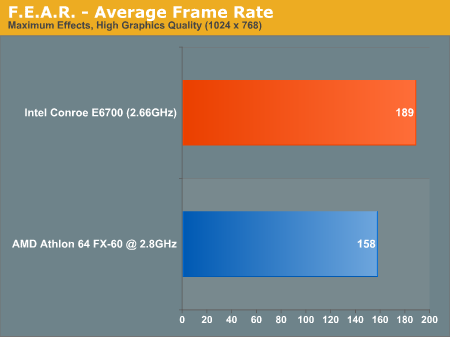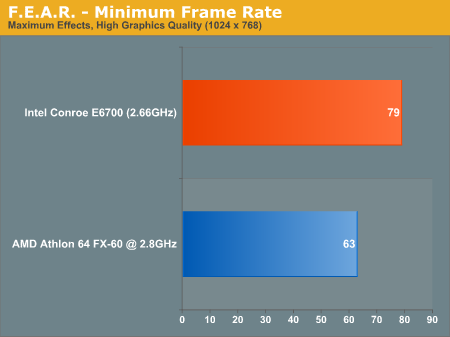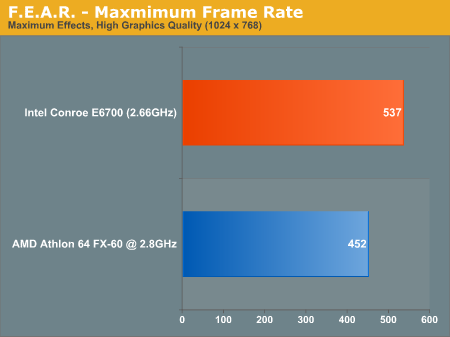Conroe Performance Preview Follow-Up
by Anand Lal Shimpi on March 9, 2006 9:30 AM EST- Posted in
- Trade Shows
The F.E.A.R. Issue
To the readers that pointed out our F.E.A.R. results as being unusually high, we owe you a sincere apology. When we went back to test Conroe for the second time we re-ran all of our tests to make sure that no mistakes were made. We caught the Quake 4 issue where Conroe’s SMP performance was understated, and we also discovered a problem in our F.E.A.R. testing.
While our intention was to test both the AMD and Intel systems at the “Maximum” Computer settings and “High” Graphics settings, only the Conroe system was configured as such. We inadvertently left the AMD system at a higher resolution (1280 x 960) instead of the default resolution (1024 x 768) when you select the “High” Graphics defaults. The oversight was entirely our own doing as Intel was not running the benchmarks or configuring them, it simply happened while we were setting up both systems at the same time. We played with different resolution settings and while deciding that we would go with one, managed to configure the two boxes differently.
Of course this means that our initial F.E.A.R. tests were incorrect, and below we have the correct results with the settings we intended to run both systems on:

The performance advantage of Conroe makes a lot more sense now, at 20% instead of 41%. With performance in Quake 4, UT2004 and HL2 in the 20 - 30% faster range on Conroe, the F.E.A.R. results now make a lot more sense.


To those who pointed out that even the CrossFire X1900 setup would be more GPU bound at 1280 x 960, you were very correct, our original results were inaccurate. We do strive for accuracy and reliability in our results here at AnandTech, which is why we went back and retested/confirmed all of our initial findings before bringing you this update. Aside from the F.E.A.R. and Quake 4 issues that we've since corrected, we found no other performance anomalies in our initial results.










96 Comments
View All Comments
RichUK - Thursday, March 9, 2006 - link
Good read good read. Thanks for the honesty and accuracy on the updates.MrKaz - Thursday, March 9, 2006 - link
Intel road map says Q4. Not Q3.And 6 months from now is Q4 not Q3.
AMD new K8 will boast performance by 10%. If .65nm boost the frequency of new K8 since .13 » .09 doesn’t seem to do pretty much on that aspect.
Then we will have some good war.
Don’t forget that this processor when working in single core have a huge L2 (4MB) vs the only 1MB from AMD. That boost the performance a lot in many applications. So the difference in Quake4, ... is amazing but not that much.
MrKaz - Thursday, March 9, 2006 - link
Sorry i mean that 6 months from now is still Q3, but intel road map says Q4.Von Matrices - Thursday, March 9, 2006 - link
Didn't that CPU have 2MB L2 and not 4MB L2?Anemone - Thursday, March 9, 2006 - link
If 20% improvement on Athlon the P4 is officially last, last, last years news, and a dog./bye P4
Anemone - Thursday, March 9, 2006 - link
You are really top rate reviewers. Check and recheck, and always forthright about things that needed correcting. Kudos!PrinceGaz - Thursday, March 9, 2006 - link
Thanks for this follow-up article, it covers pretty much every question that was raised except one. In the original article you mention "the ATI graphics driver was modified to recognize the Conroe CPU but that driver was loaded on both AMD and Intel systems". Have you any information on why it needed modifying and what was changed, and whether the changes would have any effect on the AMD system (either positive or negative).Chadder007 - Thursday, March 9, 2006 - link
I think its because they needed to change the drivers to recognize the dual core capabilities of the Conroe, since they are multithreaded capable now from ATI.redbone75 - Thursday, March 9, 2006 - link
One thing I haven't really noticed many people talking about in all of this Conroe stuff is the price to performance ratio Conroe brings. If it were released now, Conroe would offer a significant increase in performance over AMD's top offering at half the price ($540? for Conroe 2.66 and $1000+ for an FX60 right now). Sure, AMD will reduce the prices of it's processors once Intel launches the Core line and AM2 is ramping up, but I doubt it will be significant enough to entice unbiased buyers away from Conroe if it is the superior performing chip. I personally have favored Intel's chips over AMD's simply because I'm not a heavy gamer and didn't need the insane frame rates, and before dual core chips arrived I've always found my computing experience to be a little smoother b/c of hyperthreading (I've built several AMD systems for clients and friends). With the advent of dual core chips, I was eventually going to build a new system around an X2, but then when looking at the great overclockability of the Presler core and the lower price I kinda balked at that switch. Maybe others will do the same with AMD vs. Conroe: AMD might lower their prices such that buyers will go for it and simply overclock to close the performance deficit. But, then again we did just see an overclocked FX60 get bested by Conroe, at least according to current data (had to throw that in there lest the might of the fanboys smote me where I sit). Oh, well, I could be wrong, but that's my human right:-)dysonlu - Sunday, March 12, 2006 - link
Intel will charge a premium for it. You can mark my word. It's simply naive to expect the new chip to offer both the best performance AND the best value.Boy, people can so easily get carried away, being too optimistic and enthusiastic.